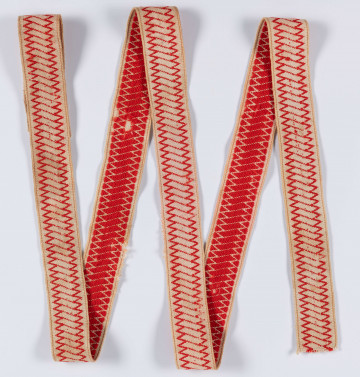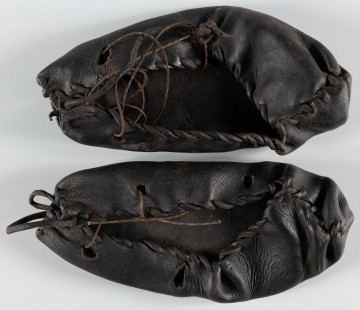
Selvage
1890 — 1910
National Museum in Lublin
Part of the collection: Folk craft of the Lublin Region (19th/20th c.)
A linen skirt worn with the Biłgoraj costume, at first only for festive occasions, later also for everyday wear. It is hand-sewn from two pieces of self-made linen fabric, made in a weaving workshop with a linen weave. One piece of fabric was usually the width of a typical loom and was called a shelf ('półka'). The skirt presented is long, 80 cm (150 cm wide), reaching almost the ankles. The upper part at the back is pleated at the sides and sewn into stitching, finished with straps. There is also a slit at this point which makes it easy to put the skirt on. The front is unlined, as it was covered by an apron that obscured the slit. The fabric is decorated all over with hand-printing, done with a board (for a description of the dyeing process, see E/393/ML, E/398/ML). The pattern is in black and has a striped arrangement. It is formed by vertically arranged small rhomboids, triangles, and crosses preceded by straight lines. The skirts were worn in the vicinity of Biłgoraj and in the south-eastern part of the Lublin region from the turn of the 19th and 20th centuries until the end of World War I. This form of fabric decoration was adopted in the 19th century. This form of fabric decoration was adopted only on skirts called 'malowanki', which were enlivened by introducing a colourful decorative motif. That was due to the lack of skill in making more complicated weaves. Housewives were preoccupied with their chores on the farm and had no such knowledge.
Author / creator
Dimensions
cały obiekt: height: 150 cm, width: 80 cm
Object type
skirt
Technique
Material
flax, canvas
Creation time / dating
Creation / finding place
Owner
The National Museum in Lublin
Identification number
Location / status

1890 — 1910
National Museum in Lublin

1901 — 1950
National Museum in Lublin

1895 — 1914
National Museum in Lublin
DISCOVER this TOPIC
National Museum in Lublin
DISCOVER this PATH
Educational path